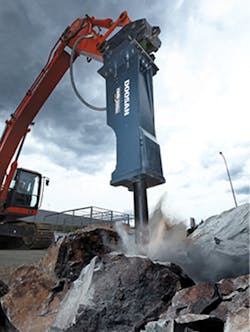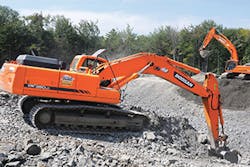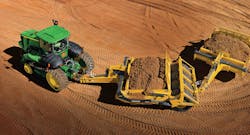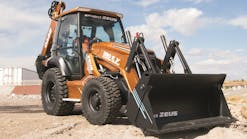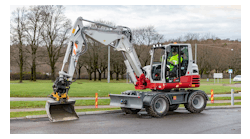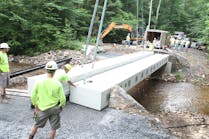Your company has successfully bid a job, and it’s time to examine the site for land clearing. What equipment will be essential? What is the process in tool selection for land clearing site preparation? How will the tools’ capabilities fit into that process, and throughout the project? How can common mistakes be avoided?
Industry experts say that the first factors to consider in selecting tools for land-clearing site preparation are to know the site requirements, job timeframe, amount to be cleared, and size of the material—including tree diameter—to be cleared.
“You will need equipment that matches the size of the job, the size of the trees that are being cleared, and the rate that you want to clear them,” notes Rob Wenzlick, Morbark regional sales manager.
Doosan Equipment hammers, digs, grabs, and scoops
There are many common mistakes contractors make in site preparation tool selecting, here are 14 of them:
- Poor planning to ensure the work is completed as scheduled. “Poor planning results in adding more machines and cost to finish,” says Boyle. “Inexperienced operators will slow the process and will cause extra machine repair. The contractor should utilize people with experience and use inexperienced operators in other areas.”Planning also is important when determining the correct location to pile the trees and brush for burning, chipping or shipping the trees. Contractors need to make sure the tree process is not in the way of production for a building or structure, Boyle says.
- Not considering the possibilities of wet weather and terrain conditions in selecting machines
- Pulling the trees over instead of pushing them over when clearing with an excavator. Boyle adds that in doing so, the tree falls on the machine.
- Bumping the tree instead of easing up, and pushing when using a dozer. “Many times when you bump a tree, the whiplash causes the tree to break and come down on the dozer,” says Boyle.
- Not hiring another contractor experienced in land clearing. Boyle says that this person will have the right machines and generally at a lower cost than the use of a company’s own equipment.
- Not choosing the correct size equipment to do the work on time. Choosing bigger equipment will not necessarily yield better results, notes Wenzlick, adding that equipment too large for the job will cost more for capital investment, burn more fuel and cost more to maintain.Althoff points out some contractors will underestimate the size of the vegetation onsite and make a selection based on price versus actual need. “They’re wanting to take down a 10-inch tree with a rotary cutter, which doesn’t work with our product models,” she says. “They need to select the right tool for the size of vegetation they have.”Making such a mistake creates more down time for a contractor in having to rent a piece of equipment or if they did rent the equipment, having to return to the rental manager to pick up the appropriate equipment for the work, Althoff says, adding that choosing the wrong piece of equipment for the job also could damage it.
- Contractors not doing their homework to make sure the equipment that is acquired for the land-clearing task meets all the requirements of the job. “When purchasing tools or equipment for land clearing, it is important to review the specs and performance of each piece of equipment,” says Wenzlick. “Make sure the tools fit into the requirements that are needed to do the job before purchasing.”
- Not being aware of the attachments available for each tractor
- Not adding extra cost into the bid to account for the wear and tear on machines when clearing trees
- Judging bucket durability by weight. “A heavy bucket is necessarily a durable bucket,” says Egan. “The quality, not the weight, of the materials is the key. A heavy bucket can actually reduce efficiency. In many cases, reduced weight may mean improved quality.” Determining how heavy duty a bucket is often comes down to investigating the materials from which it has been built, such as abrasion-resistant, high-grade steel, Egan says.
- Selecting a general purpose bucket when digging in rock or other very abrasive material. “If you’re going to be working with something really tough to dig, you may go with a smaller, rugged attachment designed specifically for the material, like a rock bucket,” says Egan. “On the other hand, grading buckets rarely offer much capacity and do not come equipped with teeth. Their shallow, wide design is built for leveling surfaces. Therefore, using a grading bucket for a digging job could frustrate an otherwise efficient operator.”
- Not considering the type of teeth needed for the bucket. “There are a wide range of options—including rock, tiger, and flair teeth—each specifically designed for a particular type of application or terrain,” says Egan.
- Not matching the proper bucket width to the trench can result in over-digging or under-digging, requiring extra time and reducing job site efficiency. Smith recommends contractors who routinely change excavator buckets purchase a quick coupler accessory, enabling more ease in switching between buckets to best match the excavating or trenching needs. “Operators can change an attachment on an excavator in a fraction of the time compared to manually using pins to connect the attachment to the excavator.”
- Not keeping the equipment serviced the way it needs to be, such as not replacing wear items when they need to be replaced. “It’s not necessarily the cost of the wear items or the cost of doing the maintenance,” says Van Rheenen. “It seems like people are getting into a hurry. They want to make that next dollar and they sometimes neglect to look at the machine and the long-term use of it. That can come back and bite you later if you neglect your machine—it causes more costs at the end.”
